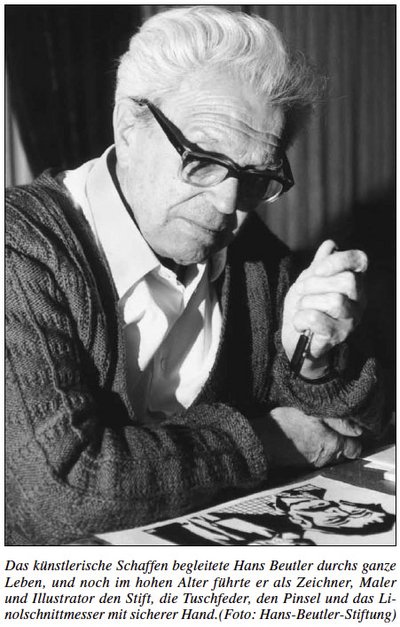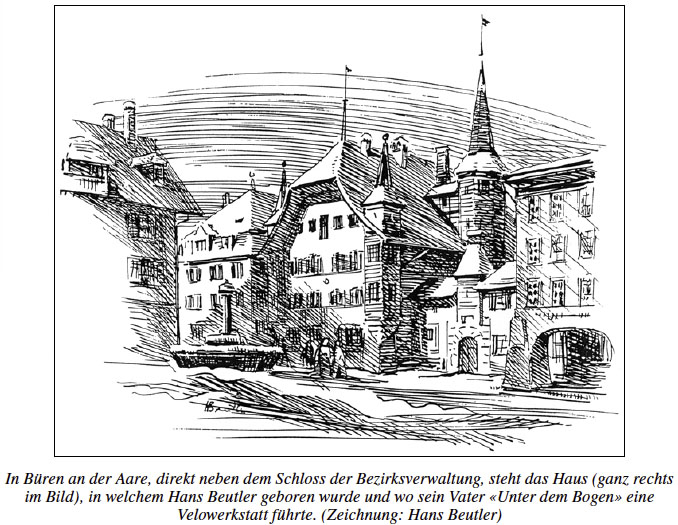“Monsieur Bötleer’s” quiet grandeur
“Monsieur Bötleer’s” quiet grandeur
A Swiss saved the lives of over 5,000 Jews in France
by Heini Hofmann
After seven decades, the world remembered the horrors of the Second World War. Hardly in the focus were the courageous escape helpers. There are well-known names among them, but also those who were forgotten, such as the artist and philanthropist Hans Beutler from Bueren on the Aare who did not even make it to an entry in the Swiss encyclopedia.

There are no mistaking certain parallels to other World War II escape helpers and Holocaust Rescuers, who acted without regard to their own lives and to their own career: St. Gallen Commander of Police, Paul Grüninger, being removed from office in 1938, who saved the lives of more than 3,000 refugees and who was even sentenced for this good deed, has not been rehabilitated posthumously before 1993. Following this, a street in Jerusalem was named after him, and in Switzerland in fact a film of his brave act was now made.
Something similar happened to Carl Lutz of the Ausserrhoden borough Walzenhausen. As Vice Consul in Budapest, the diplomat had led the biggest rescue operation of Jews, and doing so he had saved many thousands, but returning to Switzerland, Berne admonished him. After all, before his death he was still nominated honorary citizen by the community; but it took the Confederation twenty years after his death – fifty years after the end of the war – to thank him.
No official thanks
It was different for Bernese artist and philanthropist Hans Beutler, who saved more than 5,000 Jews, mostly children, from persecution and death. He was admittedly not punished for it, because he acted as a Swiss abroad. But unlike Paul Grüninger and Carl Lutz, down to the present day he was never praised by official Switzerland.
Only a decade after his death one remembered again this great philanthropist just in his borough, where he was born and where he died. Politicians and a representative of the Red Cross spoke words of acknowledgement. But then again it kept being quiet about Hans Beutler, so quiet that in 2013 even his 100th birthday and in 2014 the 20th anniversary of his death were forgotten.
In the service of the general
“Unter dem Bogen” in Bueren on the Aare, Hans Beutler saw the light of the day on 3 May 1913. This was right next to the imposing castle of the district administration, there where his father, married to a French Huguenot, led a bicycle repair workshop. His childhood was overshadowed by illness. A stay in a sanatorium compelled him into isolation, where he took refuge in children’s and storybooks.
In order to get him out of isolation, the parents sent him to the Boy Scouts, where he blossomed and even took a leading role later on. In the prewar years, he headed the International Scout Centre in Kandersteg, and in the Scout Movement, he, as v/o Mutti, made many friends, so among others with the later travel writer René Gardi.
The profession as a graphic designer, learned in Welschland, aroused his desire to artistic creation as draftsman and painter. Pen, ink pen, brush and linocut knife were his instruments of labor, which he led with ease bubbling over with ideas. In 1939, his breakthrough came with a card series “600 years Battle of Laupen”. He willingly responded to the call of the Swiss National donation as their objective to alleviate the suffering of the war corresponded to his intention. Unforgettable subjects to soldiers’ Christmas right up to the design of General Guisan’s Christmas letter made his name known all over the country.
Painter, draftsman and illustrator
Throughout his life, the talented and versatile artist worked for various publishers as book and magazine illustrator, and this even in the last years, overshadowed by painful disease. In addition to his color-intensive oil paintings and watercolors, his pen and ink drawings as well as his intaglios fare impressing. He conjured the latter with old gramophone needles in overdyed paper. He painted his pictures on everything just being available for him: on wooden boards, old cardboard boxes, even on the back of used envelopes …
But in Hans Beutler’s chest still lived a second soul – his willingness to aid. As a result of the war this willingness became even more pronounced and urged him to action. Thus in Davesco in the Ticino in 1942, he took over the lead of an internment camp for young people. Here his pedagogical natural talent attracted attention. This in turn led Rodolfo Olgiati, former head of Swiss Red Cross’ child welfare organisation, to entrust him with the management of a children’s home in France, so that he became Red Cross delegate.
Rescuer of more than 5,000 people
His arrival at the Cevennes village Le Chambon-sur-Lignon, situated on the Central Plateau in the department of Haute-Loire, in 1943 (Lignon is the name of the first tributary of the Loire) took place during the German occupation of France. In the former Huguenot village people knew what it means to be persecuted. Indeed, thanks to his selfless commitment, Hans Beutler very soon had as many as five infant homes at his disposal, and, on top of that, a number of apprentice workshops and a (donated) farmstead of 57 hectares, where French, Spanish, English and Belgian war orphans were finding shelter.
At Le Chambon-sur-Lignon, which later became the symbol of the voluntary assistance for innocent war victims provided from Switzerland, more than 5,000 Jewish children and adults were hidden and rescued from persecution and deportation during the war with the help of many local persons who assisted refugees. Unfortunately, he could not rescue all people. He became a witness of a cruel extermination campaign in the region. After the war ended, those infant homes were taken over by the French Red Cross; but apparently people did not want to miss the broad experience of their beloved “Monsieur Bötleer”.
Co-founder of the Youth Red Cross
Hans Beutler did not return to Switzerland until 1956; but he remained in service with the Red Cross, to which he gave many impulses, without ever pushing himself to the fore. He was co-founder of the Swiss Youth Red Cross, and on the occasion of the 100th anniversary of the Red Cross he launched the very first motor coaches for disabled persons, financed by money that young people had earned themselves – which was entirely in tune with his concept of dedicated help.
After the same self-help principle he realised – as a collaborative effort by the Youth Red Cross and the vocational schools from all over Switzerland and the Casa Henry Dunant in Varazze at the Mediterranean coast of Italy – another model project: within impressive 60,000 hours of work, apprentices and vocational school students turned a run-down building into a flourishing course centre for adolescents. Only his final years before he died in 1994 did he spend again in Bueren on the Aare.
A valuable stock of cultural assets
Another great passion of “Monsieur Bötleer” was collecting. That was also known to his many protégés from the period Le Chambon-sur-Lignon; they were by now living all over the world, and out of gratitude they sent him the desired objects from anywhere of the world: children’s and fairy tale books from a variety of linguistic and cultural areas, artfully decorated Easter eggs as well as children’s toys, and in particular nativity scenes from around the globe.
Fortunately, these unique collections during his lifetime found a new home at the toy and nativity scene museum in Bubendorf/BL1. Hans Beutler decided to take this step, because he felt that in the little town of Bueren on the Aare he was not really understood. Consequently, it was in Bubendorf, that his 100th anniversary was commemorated with a special exhibition in 2013.
Silently practiced brotherly love
When Hans Beutler was awarded the cultural prize of the town and district of Grenchen in 1981, his friends were highly delighted. In the laudatory speech, he was honoured for his “extraordinary work in the service of humanity” and for his “rich activities as a painter, graphic artist, illustrator, and collector of valuable cultural assets”.
The gifted artist and great humanitarian with his charming personality, a mixture of Bernese staidness and French openness to the world, put his artistry wholeheartedly at the service of his social helper activity. His life was dedicated to a brotherly love silently practiced in everyday life.
The decisive impulse
It was a Solomon-like advice that prompted him to take the decisive step at an early age. At the time a scouting friend said to him: “Imagine you were a great painter, and you were standing like Michelangelo high up on a scaffold in a large hall, and down below in the corner there was a door, at which somebody was knocking. If you are a great painter, you will stay on the scaffold and go on painting. If, however, you are a bungler you will climb down and open the door.
But it could also be that you aren’t a bungler, and still think you should open the door, because somebody may need your help. In that case you should climb down and open the door – for then you will enter a rich landscape full of surprises and new challenges – challenges you have never sought, but that will carry you through life.” Hans Beutler decided to climb down!
There are innumerable people who are greatly indebted to him, and many who owe him their lives. But modest as he was, his good deeds went largely unrecognized. In his country, he has never been officially honoured to this very day, and the only reminder of him in the town of Bueren on the Aare is a humble commemoration note at his birthplace “Unter dem Bogen”. •
1 Nativity Scenes and Toy Museum in the former village schoolhouse in Bubendorf/BL: Annual nativity scenes exhibition with exhibits from Hans Beutler from early November until the middle of January; on Sundays from 2 p.m. until 5 p.m. (free entry), Guided tours on request, www.museum-bubendorf.ch or
Phone: (0041) 61 931 32 92.
(Translation Current Concerns)
